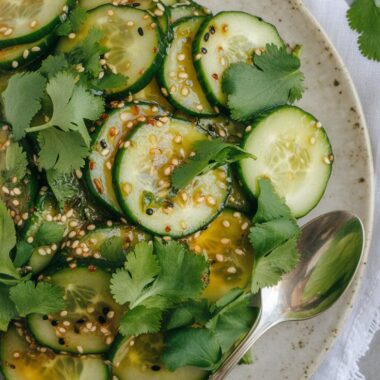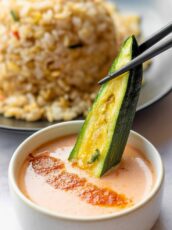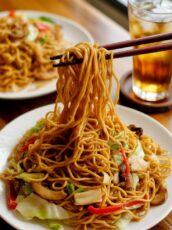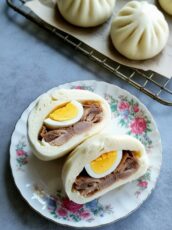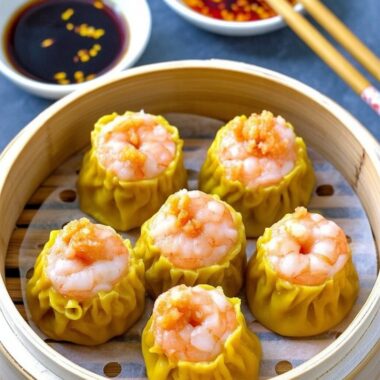There’s something about Eomuk Bokkeum that makes it feel like comfort food in its purest form. It’s spicy, sweet, and just a little bit addictive. I still remember the first time I made it at home—thinking it would just be “one of the sides” for dinner. But by the end of the meal, everyone at the table had ignored the main dish and gone straight for the fish cake stir-fry.
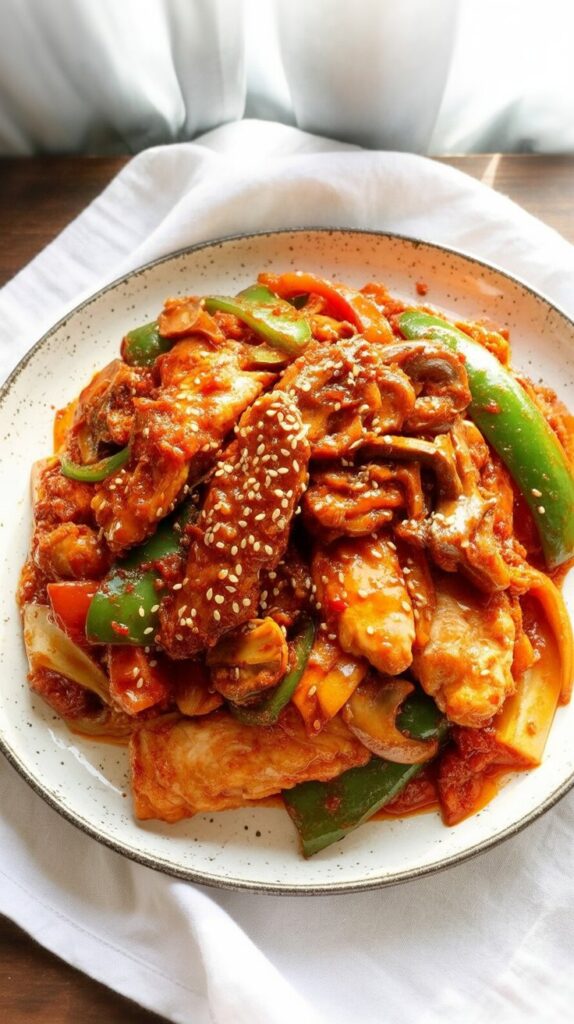
This is one of those dishes that works whether you’re eating solo with a bowl of steaming rice, or setting up a proper Korean-style spread with multiple banchan. And if you’ve got kids or friends who love tteokbokki, they’ll probably hover over the pan while it’s cooking.
Getting to Know Eomuk (Korean Fish Cake)
Eomuk is made from mild white fish, ground into a paste with starch and a few vegetables, then shaped and cooked—usually by steaming or deep-frying. I once tried making fish cakes from scratch, and let’s just say it’s one of those “glad I tried it, glad I can buy it” situations. The store-bought ones do the job perfectly and save a mountain of cleanup.
For this stir-fry, I like using the flat rectangular sheets you find in the freezer section of Asian grocery stores. They’re about the size of a small notepad and bend easily without breaking, which makes them great for quick slicing. They keep for months in the freezer, so I often toss a few packs into my cart “just in case” I need an easy side dish later in the week.
The Taste and Texture
If you’ve never tried it, eomuk has a mild seafood flavor—think more “savory snack” than “fishy.” The texture is soft and springy, a bit like firm tofu puffs, but with more chew. The stir-fry sauce really soaks in, so you get that irresistible mix of sweet, salty, and spicy in every bite.
A quick tip from my own trial and error: if you want to tone down the natural seafood aroma, give the fish cakes a quick 20–30 second soak in just-boiled water before stir-frying. It refreshes them and helps the sauce cling better.
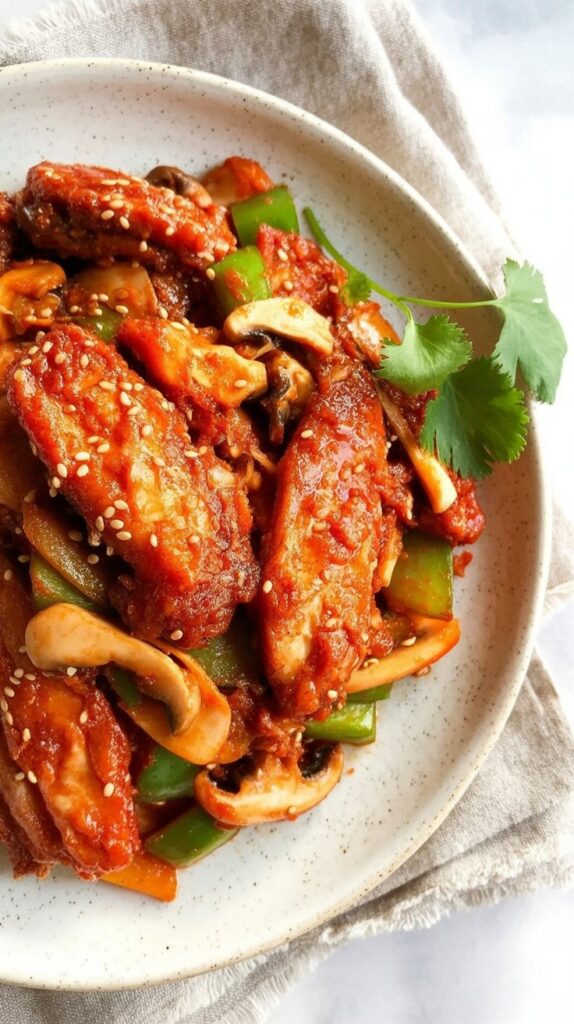
Why I Always Keep This in My Meal Rotation
Eomuk Bokkeum is perfect for busy days—prep takes minutes, and it reheats beautifully. I often make it on Sunday night so it’s ready for Monday lunchboxes. It’s one of those dishes that somehow tastes even better after a night in the fridge, as the flavors have time to mingle.
It’s also a crowd-pleaser for mixed company—spicy enough for heat lovers but not overpowering. And if you need a kid-friendly version, you can easily make it with less gochugaru and a touch more honey or sugar.
Cooking Tips from My Kitchen
- Slice thin for better sauce coverage – Cutting the fish cake into bite-sized strips means more surface area for the sauce to cling to.
- Use a hot pan – Fish cakes are already cooked, so this is really about letting them sizzle and soak in flavor quickly.
- Don’t overcook – Two to three minutes in the sauce is plenty. Any longer and the texture turns too soft.
- Adjust the heat – Gochugaru (Korean red pepper flakes) gives that signature color and spice, but you can balance it with more soy sauce or a dash of rice syrup if needed.
Serving Ideas Beyond the Basics
Sure, you can just serve this with rice and call it a day, but here are some fun ways I’ve used it:
- Lunchbox hero – Packs beautifully in a bento with kimchi, fried egg, and some greens.
- Late-night snack – I’ve been guilty of reheating a small plate with a cold beer after everyone’s gone to bed.
- Tteokbokki upgrade – Toss some into your rice cake stir-fry for an extra layer of flavor and texture.
- Korean BBQ sidekick – Balances out rich grilled meats with a spicy-sweet bite.

Storing and Reheating
This stir-fry lasts up to four days in the fridge. Store it in an airtight container, and when reheating, add just a splash of water or a drop of sesame oil to bring back that glossy finish. Once the texture turns mushy, it’s time to say goodbye.
Korean Fish Cake Stir Fry
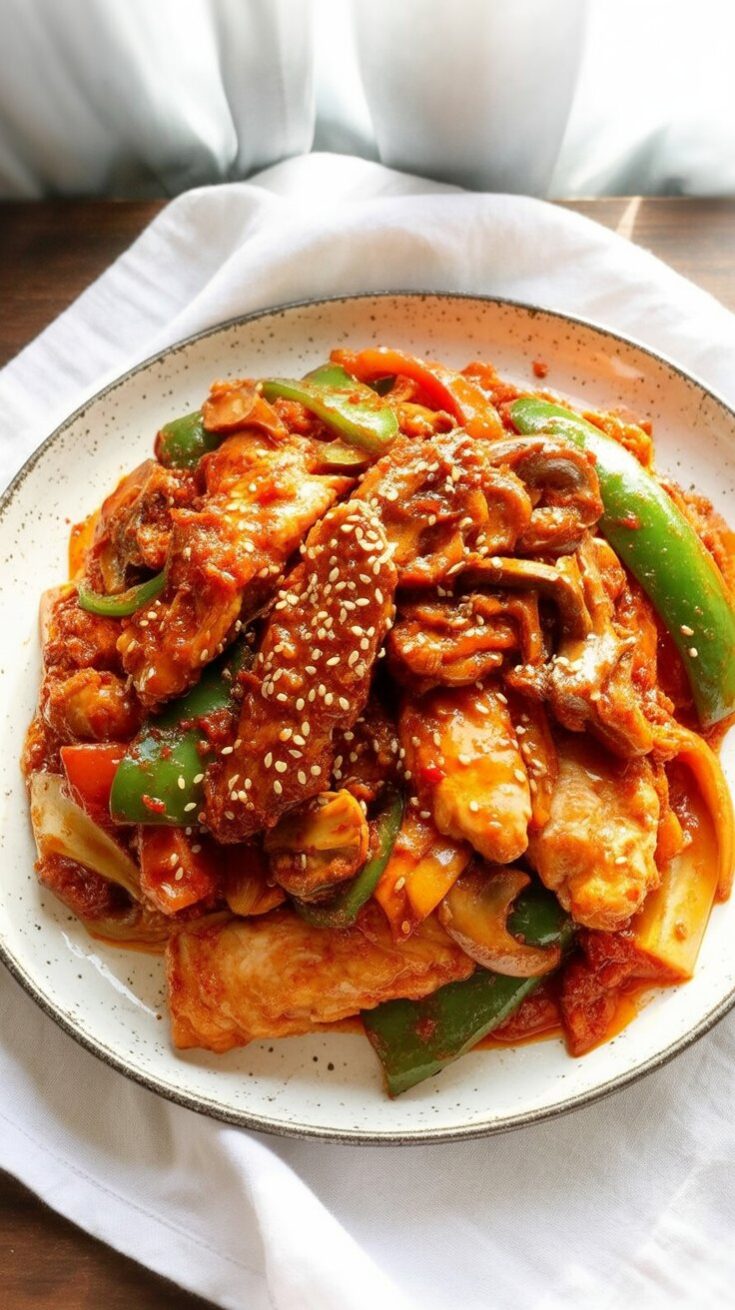
Korean Fish Cake Stir Fry is a beloved Korean side dish where tender fish cakes are stir-fried with crisp vegetables in a spicy-sweet sauce. It’s quick, flavorful, and pairs perfectly with hot steamed rice or as part of a banchan spread.
Ingredients
- 6 sheets frozen Korean fish cake (eomuk/odeng), cut
- ½ medium onion, sliced
- ⅓ medium carrot, julienned
- 1 Korean green pepper, sliced
- 2–3 tablespoons olive oil
- 3 tablespoons water
- Spicy Sauce
- ½–1 tablespoon gochujang (Korean chili paste)
- 1 tablespoon gochugaru (Korean chili flakes), coarse
- 1 tablespoon mirin
- 1½ tablespoons corn syrup
- 3 tablespoons chopped scallions
- 1 tablespoon minced garlic
- 1 tablespoon Korean soy sauce
- 1 pinch black pepper
- 1 teaspoon sugar
- ½ tablespoon sesame oil
Instructions
- Place the frozen fish cake sheets in a large heatproof bowl. Pour in boiling water until the fish cakes are submerged. After about 30 seconds, drain and let cool in a strainer.
- While the fish cakes cool, prepare the onion, carrot, and green pepper, placing them on a plate or tray. Mix all spicy sauce ingredients in a separate bowl and set aside.
- Cut the cooled fish cake sheets into triangle pieces.
- Heat a non-stick skillet over medium-high heat and add olive oil. Once hot, toss in the fish cakes, onion, carrot, and green pepper. Stir-fry for about 3–4 minutes until the fish cakes turn lightly golden.
- Pour the prepared sauce into the pan, stirring quickly to coat everything evenly. Add the water and cook for 1 more minute to bring the flavors together.
- Turn off the heat, drizzle with sesame oil if desired, and garnish with sesame seeds. Serve immediately with a bowl of hot rice.
Notes
- Adjust the spice level by adding more or less gochujang and gochugaru.
- This dish is best enjoyed fresh, but leftovers can be stored in an airtight container in the fridge for up to 2 days.
- Works well in lunchboxes and as part of a banchan spread with other Korean side dishes.
Nutrition Information:
Yield: 3 Serving Size: 1Amount Per Serving: Calories: 1156Total Fat: 111gSaturated Fat: 15gTrans Fat: 0gUnsaturated Fat: 93gCholesterol: 54mgSodium: 1238mgCarbohydrates: 35gFiber: 2gSugar: 20gProtein: 9g
Asianplated.com, occasionally offers nutritional information for recipes contained on this site. This information is provided as a courtesy and is an estimate only. This information comes from online calculators. Although allchickenrecipes.com attempts to provide accurate nutritional information, these figures are only estimates.
Quick Questions People Often Ask Me
Can I make it less spicy?
Absolutely—reduce the gochugaru and swap in a little extra soy sauce or sugar for balance.
Do I have to soak the fish cake in hot water first?
No, but I like doing it for a cleaner flavor. Just don’t soak too long or you’ll lose some taste.
Can I use other shapes of eomuk?
Yes—cylindrical or cubed ones work too, though you may need to adjust slicing and cooking time.
Try other Korean recipes:

